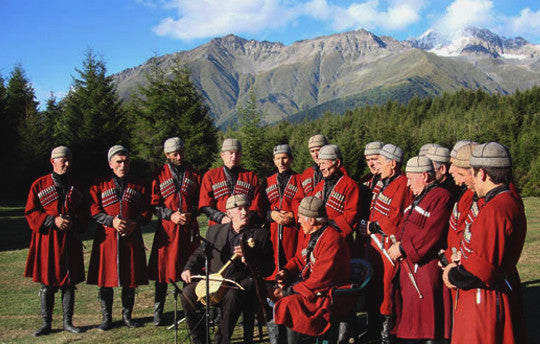Your Cart is Empty

Warm, fertile and surrounded by the spectacular beauty of the Caucasus mountains, Georgia's music is inextricably linked to geographical isolation, a mythical fixation with feasting and an ancient Christian faith going back to the 4th Century. Such conditions have fostered an awesomely rich folk tradition, characterised most recognizably by the mesmerising vocal polyphony which is a basic ingredient in almost all church and folk music, and remains widespread to this day in both city streets and country lanes. Only relatively recently has a new and more Westernized urban pop taken hold - though most exponents also remain able folk performers.
The Georgian myth of national creation goes something like this: when God was creating the earth and distributing land among its peoples, the Georgians were too busy drinking and feasting to turn up on time. When they finally arrived there was nothing left. 'But Lord', they protested, 'we were only late because we were toasting You!' Touched by this sentiment, God gave them the land He had been keeping for himself...
Ever since, feasting has been central to Georgian society and still provides the principal occasion for making music. People gather for a lavish picnic at the slightest excuse, led by a tamadaor 'toastmaster' in dedicating toasts to God, long life and the ancestors, among other things. Each toast is accompanied by an appropriate song, as well as snippets of wisdom from the tamada.
Georgian polyphony is usually in three parts and is generally sung by men, although women's groups do exist. Mixed groups are unusual - the ending note of most Georgian songs is in unison and the octaves produced with mixed gender voices are avoided. The 'melody' tends to be sung by the middle voice, with the upper and lower supports weaving complex harmonies around it. The mountainous terrain has ensured that there are many regional variances, though the most marked is that between east and west.
Kakhetia in the East, famous for its wine, is - unsurprisingly - equally noted for its drinking and table songs, as well as being home to some of the richest, most sonorous styles of polyphonic singing. Kakhetian songs feature two solo voices, intertwining - like tangled vines, some say - over a slowly moving drone sung by the rest of the singers. Shimmering clashes and dissonances, tensions and releases, harmonies colliding like slowly moving tectonic plates; 'Chakrulo', a stunningly beautiful drinking song, was among the earthly music sent into space with the Voyager spacecraft in 1977.
In the western regions of Guria and Mengrelia the bass lines are more athletic and the whole style is more virtuosic; here the dissonances so strange to Western ears and so beloved of Georgian ones are even more acute. The men sing in a high 'head-voice' and a soloist indulges in a spectacular form of yodelling, known askrimanchuli, with striking leaps and rhythmic patterns. These songs, which may include four independent parts, and often form battle chants or epic stories, have become showpiece favourites for the professional choirs performing on the concert platform.
Finally, Svanetia, isolated high up in the Caucasus mountains to the North of the country, cut off for up to eight months of the year by snow, and the region where some of the oldest traditions have survived. Escaping many of the invasions that have affected the rest of the country over the centuries, the villages of Svanetia still have spectacular medieval-style towers, as well as customs and rituals having their origins in pre-Christian times. The music sounds somewhat archaic and severe, with some distinctly angular and unpredictable harmony and a comparatively narrow range. Ritual songs to the sun and to St George are hugely popular in Svanetian areas, occasionally accompanied by the ancient Svanetian harp (changui) and bowed viol (chuniri).
Among the founders of the Rustavi choir, the first in Georgia to encompass songs and members from all of its regions and one of the few to have an ongoing presence in the West, was Hamlet Gonashvili. Gonashvili's distinctive lead style is often still considered 'the voice of Georgia', earning him the nation's highest honours and prizes. A highly influential interpreter and teacher of folk music from the Kartli and Kakheti regions, he died in 1985, having fallen from an apple tree.
Although polyphonic songs can be heard from high-rise flats in Tbilisi to village weddings in Svanetia, there's a very different style of 'urban music', to be heard on car-radios and in city bars. Replacing the idiosyncratic harmonies of Georgian polyphony are sentimental songs, with hummable melodies, often accompanied by a guitar. The most famous of these is 'Suliko', a ballad of love lost immortalised as Stalin's favourite song (Stalin was himself Georgian).
A rougher and livelier sort of music, known asdudukebi, is played (and sung) by instrumental groups around Georgia. They often feature a clarinet or a pair of duduks (duduki, soft reedy oboes of Armenian origin) accompanied by accordion and a doli(a double headed drum). Wild and raucous, the music provides a link between Georgia, Azerbaijan and Armenia, and compelling examples can be found across the Transcaucasian region.
Special mention must go to Orera, who during the post-war Soviet period became a legendary force for Georgian music, famous for combining vocal polyphony with some swinging jazz musicianship and a boyish easy manner. The group is still touring today and the video to their stunning hit 'Krimanchuli' is still a delight to watch, providing an extraordinary image of a lost era, as visually intriguing as it is sonically exciting.